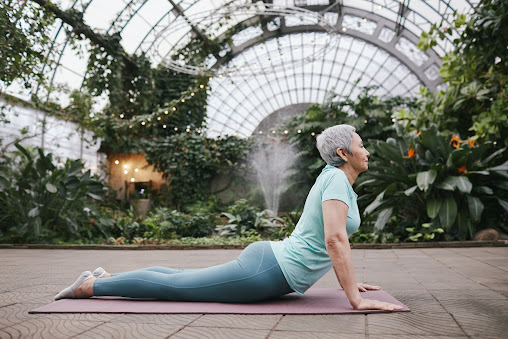The word "Hatha" is derived from two Sanskrit words, "Ha" meaning sun, and "Tha" meaning moon. Hatha Yoga is meant to balance the opposing forces of the body, such as the left and right sides, the masculine and feminine energies, and the hot and cold energies. Hatha Yoga is one of the most popular types of yoga practiced worldwide. It is a physical form of yoga that focuses on building strength, flexibility, and balance through asanas (postures) and pranayama (breathing techniques).In a typical Hatha Yoga class, practitioners will perform a series of asanas that range from gentle to challenging, depending on the skill level of the student. These postures can help to increase flexibility, strengthen muscles, improve balance, and enhance overall physical well-being. Pranayama is also an essential part of Hatha Yoga, and it involves breathing techniques that can help to calm the mind, reduce stress and anxiety, and improve lung function.
2. Vinyasa
The word "vinyasa" comes from the Sanskrit word "Nyasa," which means "to place," and "vi," which means "in a special way."Vinyasa Yoga is a popular type of yoga that emphasizes linking movement with breath. In a Vinyasa Yoga class, students move through a flowing sequence of yoga postures that are synchronized with their breath. Each movement is coordinated with either an inhale or an exhale, and the transitions between postures are smooth and fluid. Vinyasa Yoga is often referred to as "flow" yoga because of the continuous movement from one posture to another. The sequences of postures can be varied, so each class can offer a unique experience. Vinyasa Yoga is often practiced in a heated room to enhance the flow and promote detoxification through sweating. Vinyasa Yoga can be physically challenging, as it requires strength, flexibility, and balance. However, modifications can be made for students of all levels, making it accessible to beginners and advanced practitioners alike. The benefits of Vinyasa Yoga include increased strength, flexibility, and cardiovascular health. It can also improve mental focus and reduce stress and anxiety.
3. Ashtanga
Ashtanga Yoga is a dynamic and physically demanding type of yoga that involves synchronizing breath with a series of progressive postures. It is often referred to as "power yoga" due to its intense and vigorous nature. Ashtanga Yoga was developed by Sri K. Pattabhi Jois in the early 20th century in Mysore, India. The practice is composed of six series of postures, each increasing in difficulty and building upon the previous series. The first series, known as the Primary Series, is the most widely taught and practiced. Ashtanga Yoga is traditionally practiced in a specific sequence, with each posture held for five breaths before moving on to the next. The practice also includes ujjayi breath, a specific type of breathing that creates internal heat and helps to detoxify the body. The benefits of Ashtanga Yoga include increased strength, flexibility, and cardiovascular health. It can also improve mental focus and reduce stress and anxiety. Ashtanga Yoga is a challenging and rewarding practice that can help students to develop greater self-discipline, determination, and resilience.
4. Bikram
Bikram Yoga is a type of hot yoga that involves practicing a specific sequence of 26 postures and two breathing exercises in a heated room. It was developed by Bikram Choudhury in the 1970s. Bikram Yoga classes are typically 90 minutes long, and the room is heated to around 105 degrees Fahrenheit with a humidity of 40%. The heat is meant to help students loosen their muscles, increase flexibility, and promote detoxification through sweating. The 26 postures and two breathing exercises are performed in a specific sequence, and the same sequence is used in every class. Each posture is held for a specific amount of time, and the breathing exercises are done between postures to help regulate the body's temperature and improve oxygenation. The benefits of Bikram Yoga include increased strength, flexibility, and cardiovascular health. It can also improve mental focus and reduce stress and anxiety. Some students also report improvements in conditions such as back pain, arthritis, and insomnia.
5. Iyengar
Iyengar Yoga is a type of yoga that emphasizes precision and alignment in the practice of asanas (postures) and pranayama (breath control). It was developed by B.K.S. Iyengar, a renowned yoga teacher who lived from 1918 to 2014. Iyengar Yoga is characterized by the use of props, such as blocks, straps, blankets, and chairs, to help practitioners achieve correct alignment and better understand the poses. The use of props makes Iyengar Yoga accessible to people of all ages and abilities and allows for a deeper and safer practice. In an Iyengar Yoga class, the teacher will guide students through a series of poses, paying close attention to alignment and providing individualized adjustments as needed. The class may also include pranayama exercises and relaxation techniques. Iyengar Yoga is known for its therapeutic benefits and is often recommended for people with injuries or chronic conditions. The precise alignment principles and use of props can help students recover from injuries, improve posture, and build strength and flexibility.




